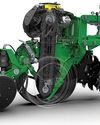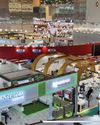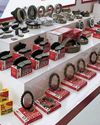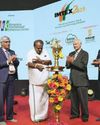ADAPTIVE V2V CHARGERS

In today's age, there is an ongoing debate on the usage of fossil and it's alleged significant contribution to carbon emissions. With the transportation sector known to being the second largest consumer of fossil fuels, to restore the balance, Battery Electric Vehicles (BEV) are the flavour of the season. However, a major challenge with the widespread adoption of EVs is the limited availability of charging infrastructure leading to longer charge times and inconvenience for users. A potential solution to eliminate this problem is to use Vehicleto-Vehicle (V2V) chargers. V2V chargers in a way take the load of the grid and are positioned as the next best alternative to enhance the infrastructure.
The students of Mahindra University developed versatile and adaptive V2V chargers derived from bi-directional converters. Bi-directional converters' significance increasing rapidly as these can be used for Vehicle-toGrid (V2G) and Grid-to-Vehicle (G2V) applications. Various bidirectional converters are available for these types of applications in isolated and non-isolated topologies.
➤ Non-isolated bidirectional converters
A non-isolated bidirectional converter, featuring a half-bridge configuration with two switches, inductors, and capacitors on either side, serves as an effective method for charging one EV with another. This converter is designed with fewer components, costeffectiveness, and ease of operation when compared to alternative nonisolated topologies.
In the development and testing phase, this bidirectional converter simulated real-world EV scenarios positioning two batteries on either side of the converter to mimic the dual battery setup found in cars. The power flow is controlled using a current reference, allowing the high-side battery to charge the low-side battery and vice versa.
Denne historien er fra June 2024-utgaven av Auto Components India.
Start din 7-dagers gratis prøveperiode på Magzter GOLD for å få tilgang til tusenvis av utvalgte premiumhistorier og 9000+ magasiner og aviser.
Allerede abonnent ? Logg på
Denne historien er fra June 2024-utgaven av Auto Components India.
Start din 7-dagers gratis prøveperiode på Magzter GOLD for å få tilgang til tusenvis av utvalgte premiumhistorier og 9000+ magasiner og aviser.
Allerede abonnent? Logg på

JOHN DEERE'S AUTONOMOUS LEAP
John Deere's CES launches underscore its commitment to real-world customer solutions. It is addressing the critical labour shortage and operational efficiency challenge, writes Upendra Kasbekar.

SUPPLIERS ALIGN WITH OEMS
The Bharat Mobility Global Expo 2025, surpassed expectations with its expansive and innovative components display. It is a testimony to tier suppliers and ancillaries steering towards the future value chain, writes Ashish Bhatia.

INTEGRATED DRIVELINE SOLUTIONS
As the automotive industry moves towards electrification and intelligent mobility, integrated driveline solutions are a fundamental requirement, writes Upendra Kasbekar.

MAHLE GROUP RESTRUCTURING
MAHLE is undergoing a transformative restructuring as part of its “MAHLE 2030+” strategy, aimed at accelerating its transition towards electrification and thermal management.

ADDON BRAKING SYSTEM FOR SMART CONTROL
Braking technology has evolved beyond just stopping power; it now ensures intelligent control, efficiency, and accident prevention, writes Upendra Kasbekar

COCKPIT ELECTRONICS AND SMART ACCESS
A smaller Indian cockpit electronics market has significant growth potential and requires modernisation. Indian suppliers are ready, writes Ashish Bhatia.

INDIA IS FIGHTING FIT
In 2024, India's defence sector witnessed substantial developments in vehicle modernisation, infrastructure enhancement, and strategic partnerships, writes Ashish Bhatia.

IMTEX 25 SPOTLIGHTS TECHNOLOGICAL CHANGES
The Bangalore International Exhibition Centre (BIEC) was once again the epicentre of technological advancements and industrial collaboration as the Indian Machine Tool Manufacturers’ Association (IMTMA) successfully concluded the IMTEX, Tooltech & Digital Manufacturing 2025.

UNION BUDGET 2025 TRADE OFF AND GROWTH IMPETUS
The Union Budget 2025, presented amidst a charged parliamentary session, maintained the course for India’s economic future and ended with a surprise forego to boost growth, writes Ashish Bhatia

BRAKE WEAR TESTING: CORRELATION BETWEEN VEHICLE AND DYNAMOMETER TESTING (PART 2 OUT OF 3)
This research focuses on reducing the mileage of open-road brake tests by simulating brake patterns on dynamometers, writes Fabio Squadrani, Senior Manager, Braking Systems in Applus IDIADA.
